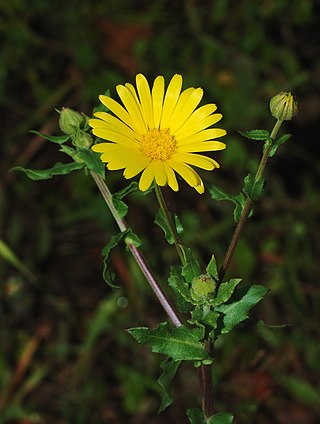
Calendula is a genus of about 15–20 species of annual and perennial herbaceous plants in the daisy family, Asteraceae that are often known as marigolds. They are native to southwestern Asia, western Europe, Macaronesia, and the Mediterranean. Other plants known as marigolds include corn marigold, desert marigold, marsh marigold, and plants of the genus Tagetes.
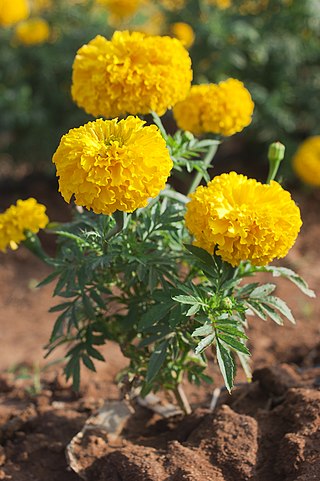
Tagetes is a genus of 50 species of annual or perennial, mostly herbaceous plants in the family Asteraceae. They are among several groups of plants known in English as marigolds. The genus Tagetes was described by Carl Linnaeus in 1753.

Kerria japonica, commonly known as Japanese kerria or Japanese rose, is a deciduous, yellow-flowering shrub in the rose family (Rosaceae), native to China, Japan and Korea. It is the only species in the genus Kerria. In the wild, it grows in thickets on mountain slopes. Japanese kerria has been used for medicine and is also planted in gardens. A double-flowered cultivar, K. japonica 'Pleniflora', is commonly called bachelor's buttons.

Tagetes erecta, the Aztec marigold, Mexican marigold, big marigold, cempaxochitl or cempasúchil, is a species of flowering plant in the genus Tagetes native to Mexico and Guatemala. Despite being native to the Americas, it is often called the African marigold. In Mexico, this plant is found in the wild in the states of México, Michoacán, Puebla, Veracruz and Guerrero.

Calendula officinalis, the pot marigold, common marigold, ruddles, Mary's gold or Scotch marigold, is a flowering plant in the daisy family Asteraceae. It is probably native to southern Europe, though its long history of cultivation makes its precise origin unknown. It is also widely naturalised farther north in Europe and elsewhere in warm temperate regions of the world.

Calendula maritima, known as the sea marigold and trailing calendula, is a very rare species from the family of Asteraceae. Some scientists regarded it as Calendula suffruticosa subspecies maritima.

Calendula arvensis is a species of flowering plant in the daisy family known by the common name field marigold. It is native to central and southern Europe, and it is known across the globe as an introduced species.
Allium melitense is a species of wild leek endemic to the Maltese archipelago. The species was first described as a variety of Allium ampeloprasum by Stefano Sommier and Alfredo Caruana Gatto in their Maltese flora published in 1915, while emphasizing its observable differences with A. ampeloprasum and the need for further study. The taxon was then elevated to species by Raffaele Ciferri and Valerio Giacomini, and again by Mifsud & Mifsud in 2018.

Andryala integrifolia, also known as common Andryala, is a species of flowering plant in the family Asteraceae.
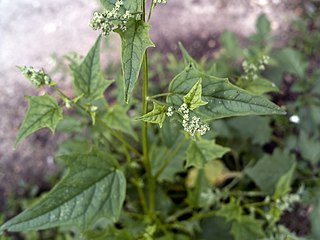
Chenopodiastrum hybridum is a species of flowering plant in the family Amaranthaceae. It is found in Europe and Asia.
Sporobolus aculeatus is a species of plants in the family Poaceae.
Freesia × kewensis is a species of plant in the family Iridaceae. It is an artificial hybrid between Freesia corymbosa and Freesia leichtlinii subsp. alba.
Opuntia dejecta is a species of plant in the cactus family. They are listed in cites appendix ii. Flowers are visited by the broad-billed hummingbird.
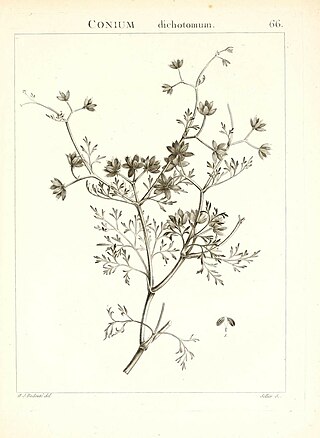
Krubera peregrina is a species of plants in the family Apiaceae. It is the only species in the genus Krubera.

Lampranthus multiradiatus, synonyms including Lampranthus roseus, known as the creeping redflush or rosy dewplant, is a species of shrub in the family Aizoaceae. They are succulent plants with grey-green shoots. They have a self-supporting growth form and simple, broad leaves. The daisy type flowers have yellow centres and petals that vary between pink and purple depending on the season.
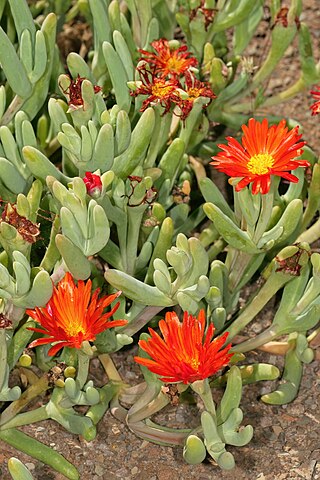
Malephora purpureocrocea is a species of plant in the family Aizoaceae, native to the Cape Provinces of South Africa. It differs from Malephora crocea by a purplish colour at the lower surface of the petals. Closely related to Malephora crocea which has a reddish colour at the lower surface of the petals in contrast to a violet-purple one in M. purpureocrocea. Some authors considered the two species as varieties or subspecies. It is the second most successful naturalised species in Maltese natural habitats within the Aizoaceaa species after Carpobrotus acinaciformis. A large population the size of 100 x 50m is found at the Cumnija area in Mellieha, near the sewage treatment plant.

Valeriana eriocarpa is a species of flowering plant in the family Caprifoliaceae. It is an annual native to western and southern Europe, northwestern Turkey, and north Africa.

Vicia monantha, the barn vetch, is a widespread species of annual herb in the family Fabaceae. It native to the Mediterranean region, and western and central Asia, and has been introduced to Australia. Typical of vetches, it has a climbing habit and pinnate leaves.
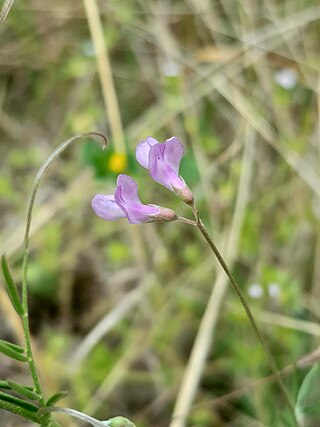
Vicia parviflora, the slender vetch, is a species of annual herb in the family Fabaceae. They are climbers and have compound, broad leaves. Individuals can grow to 0.24 m.

Scorzonera laciniata, also known as cutleaf vipergrass, is a species of herb in the family Asteraceae.















